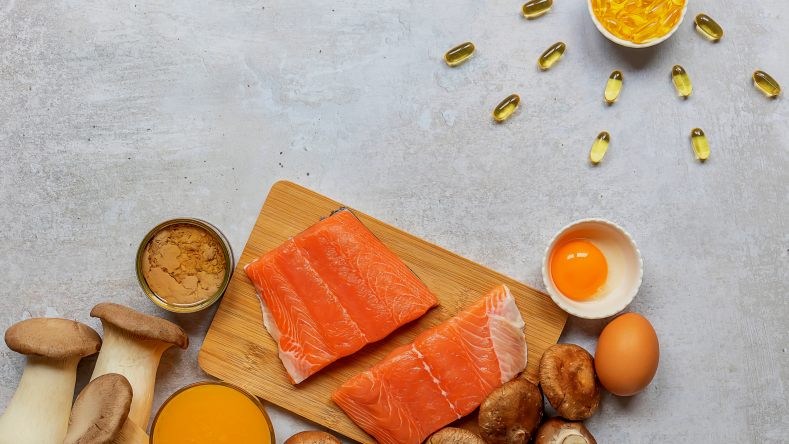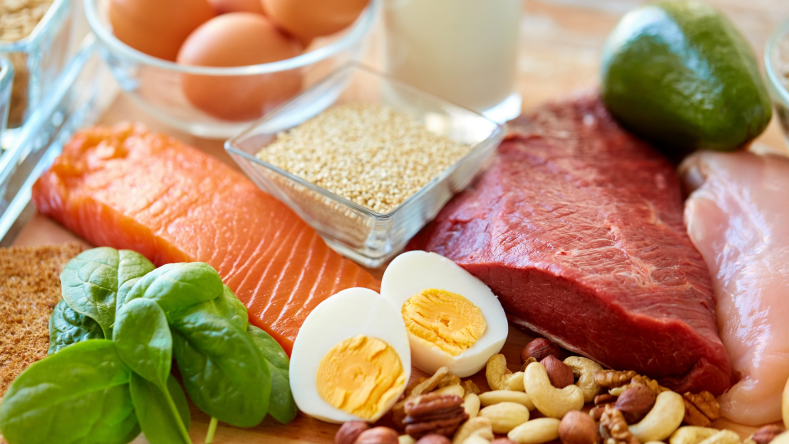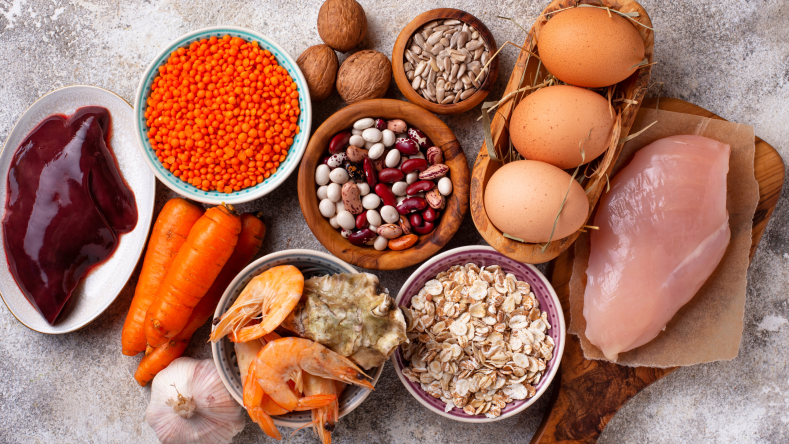The best bone health supplements, according to science
Maintaining good bone health throughout your life is important to help reduce the risk of fractures and osteoporosis. While weight-bearing exercises are great for slowing bone loss, nutrition also plays a crucial role. Here’s what science has to say about the best supplements for bone health.

There’s no denying the importance of strong bones; after all, your structural integrity depends on them. While weight-bearing exercises and certain lifestyle changes can absolutely make a difference, you can also eat your way to better bone health. But what nutrients should you focus on, and does supplementation make a difference?
Before we dive into some key nutrients (and subsequent supplements) for bone health, let’s first understand why bone health is important and how hormones, genetics and dietary preferences can contribute to bone disease.
Why does bone health matter?
Bones are a vital part of the human body, as they not only offer structural support, but also help to protect the brain, heart and other organs from injury, and store important minerals (like calcium and phosphorus) for future use.
Lifestyle choices, genetics, hormones, medical conditions, and diet all play an important role in bone health, but if one (or more) of these factors is compromised, the result can lead to weak and brittle bones. Over time, this might translate into bone fractures, osteopenia, or even progress to osteoporosis, a bone disease that is marked by progressive loss of bone mineral density and compromised bone strength [ 1
Risk factors for osteoporosis
It’s estimated that more than 200 million people worldwide suffer from osteoporosis, with aging women being the most vulnerable group. Moreover, nearly 1 in 3 women over the age of 50 years will experience osteoporotic fractures, since the hormone changes that happen during menopause negatively affect bone density [ 1 1
Unfortunately, osteoporosis does not usually present with any noticeable symptoms, so you may not realize you have the disease until a bone fracture occurs. However, some common risk factors for osteoporosis include [ 2
Race, age and gender. Even though anyone can develop osteoporosis, it is more common with Caucasians, older people, and women [
3
].Body size. If you have a more slender build, you could be at a greater risk for developing osteoporosis compared to those of larger stature.
Family history. The risk of developing osteoporosis can increase if you have a family history of the disease.
Changes to hormones. Changes in estrogen levels from menopause can lead to osteoporosis [
4
].Other medical conditions. Conditions, such as gastrointestinal diseases, rheumatoid arthritis, certain types of cancer, HIV/AIDS, and anorexia nervosa can contribute to developing osteoporosis.
Lifestyle. If you are sedentary,
consume excess alcohol
(>2 drinks/day), and/or smoke, you could be at a greater risk of developing osteoporosis. Alcohol consumption is associated with elevated cortisol levels (which can result in reduced bone density), whereas smoking decreases calcium absorption.Dietary preferences. Studies show that people who follow a vegetarian or vegan diet have a higher risk of developing osteoporosis and experiencing hip fractures when compared to those who eat animal products, likely due to a lesser dietary emphasis on bone-building nutrients, like protein, calcium and Vitamin D [
5
].
Bone health supplements
Diet plays a major role in bone health, and while you can obtain important nutrients from food, supplementation may be necessary to bridge any gaps, especially among certain populations. Here are some nutrients of concern for bone health, along with their recommended amounts, dietary sources, and supplementation needs.

Calcium
Calcium is the most abundant mineral in the body and is essential for blood vessel contraction and dilation, muscle function, blood clotting, nerve transmission, hormone secretion, as well as aiding in structure for strong bones and teeth [ 6
When dietary consumption of calcium is lacking, your body takes calcium out of the bone to keep calcium levels stable in other parts of the body. Over time, calcium deficiency can lead to weak bones, fractures and osteoporosis; in severe cases, neurological symptoms, congestive heart failure, and seizures may occur.
How much calcium do you need?
The recommended daily amount (RDA) for calcium is 1,000 mg for most adults 19 – 70 years of age, and 1,200 mg for women over 50 and men over 70 [ 6
Dietary sources
Calcium can be found naturally in dairy products, such as milk, yogurt, and cheese, while other sources include canned fish with bones, certain vegetables (such as kale, broccoli, and bok choy), and fortified foods (such as cereals, fruit juices, and tofu).
Interestingly, dairy products have a higher absorption rate than plant sources (which contain oxalic acid), which explains why plant-based eaters might be lacking in calcium and may benefit from a supplement [ 6
Supplementation
Evidence shows that less than 22% of men and less than 10% of women meet their recommended calcium intake through diet alone, so supplementation may be necessary to reach those needs [ 6
There are a few types of calcium supplements to consider, namely calcium carbonate and calcium citrate. The former contains the highest amount of elemental calcium (and should be taken with food), but calcium citrate supplements are more easily absorbed (especially with those on heartburn medications) and can be taken on an empty stomach.
Calcium supplements typically contain between 200 - 500 mg of calcium, but research shows that absorption from calcium supplements is highest at doses of 500 mg or less, so there is no need to supplement more than 500 mg at one time [ 6
Furthermore, emerging evidence suggests that calcium supplements might raise the risk of myocardial infarction and coronary artery disease, as they rapidly increase circulating calcium levels [ 7 33
Calcium functions best when paired with vitamin D, as this combination further helps the body process and absorb calcium.

Vitamin D
Vitamin D
This fat soluble vitamin plays a crucial part in maintaining strong bones, reducing COVID-19 severity, and supporting immune and brain health. Additionally, vitamin D plays an important role in maintaining bone health, as it increases calcium absorption in the gut and helps to regulate calcium and phosphorus in our bones. As such, low vitamin D levels can contribute to the development of osteoporosis, rickets, and other bone diseases [ 8
How much vitamin D do you need?
The RDA for people between the ages of 1 and 70 is 600 IU/day, with this number increasing to 800 IU/day for adults over 70 [ 9 10 11 12 13
Dietary sources
Vitamin D2 is present in plants and fungi (such as irradiated yeast and certain mushrooms), while vitamin D3 comes from animal sources, such as oily fish, egg yolks, cheese, and beef liver. Many foods are also fortified with vitamin D, including dairy and plant-based milk, yogurt, orange juice, and breakfast cereals.
Supplementation
Since many people do not get sufficient daylight year-round to produce adequate vitamin D, and it’s only found in a few foods, deficiency is extremely common (42% of the general population is deficient, and 90% of Elo members start with low levels), so supplementation may be necessary to meet your needs [ 8
Based on a thorough review of the research, we classify vitamin D status as follows at Elo:
Very low: <20 ng/mL
Low: 20-40 ng/mL
Optimal: 40-80 ng/mL
Elevated: 80-100 ng/mL
High: >100 ng/mL
If your vitamin D level is <20 ng/mL you are likely vitamin D deficient.
A daily dose of 1,000–2,000 IU of vitamin D3 is sufficient to meet most people’s needs, with the safe upper limit set at 4,000 IU/day [ 9 14
Some studies also suggest that consuming adequate amounts of magnesium is essential for activating vitamin D, so supplementing with magnesium may also be helpful if your levels are low [ 15 16

Protein
Protein 17
Protein is also positively correlated with bone health, as studies have found that adequate protein intake is associated with better bone strength, a slower rate of bone loss, and reduced risk of hip fracture, especially among the elderly [ 18
How much protein do you need?
How much protein you need per day varies with age and can increase significantly with physical activity, injury, and/or illness. The Dietary Reference Intake (DRI) for protein for adults is as follows:
Sedentary men and women: 0.8 g protein/kg of body weight/day [
19
]Sedentary adults over 65 years old: 1 to 1.2 g protein/kg of body weight/day [
20
]Athletes and highly active people: 1.2-2.0 g protein/kg of body weight/day, depending on training needs and goals [
21
]
These numbers will vary depending on your activity level, age, and other needs, so talk with a dietitian or your healthcare provider to see what is right for you.
Dietary sources and supplementation
Good protein sources include eggs, dairy, lean meat, poultry, fish, beans, lentils, soybeans, tofu, and supplements (such as protein powder
However, some athletes, weight lifters, older adults, active individuals, vegetarians/vegans, and individuals with a chronic illness may find it challenging to get enough quality protein from foods, so this population may benefit from using a protein powder supplement to help meet their protein goals.

Vitamin B12
Vitamin B12 is a water-soluble vitamin that is necessary for the development, myelination, and function of the central nervous system, as well as red blood cell formation and DNA synthesis [ 22
It’s also crucial for rebuilding bones, as a vitamin B12 deficiency has been associated with increased fracture risks, lower bone mineral density, and reduced bone turnover, especially in those who follow a vegetarian or vegan diet [ 23 24 25
How much vitamin B12 do you need?
The RDA of vitamin B12 for teenagers and adults is 2.4 mcg/day, whereas for pregnant and breastfeeding women, the RDA increases to 2.6 and 2.8 mcg/day, respectively [ 22
Dietary sources
Fish, meat, poultry, eggs, dairy, and fortified foods (such as breakfast cereals and nutritional yeast) are excellent sources of vitamin B12 [ 26
Supplementation
Since many dietary food sources of vitamin B12 come from animal products, plant-based eaters are at a greater risk for a B12 deficiency. It’s estimated that 62% of pregnant women, 32 - 43% of young adults, 25 - 86% of children, and 21 - 41% of adolescents who eat a vegetarian diet are deficient, with these numbers further increasing for vegans. If you follow a vegan or vegetarian diet, it is recommended to consume fortified foods or supplements to meet your B12 requirements [ 27
True vitamin B12 deficiency is typically treated with vitamin B12 injections to eliminate any barriers to absorption; however, high doses of oral vitamin B12 might also be effective. Oral vitamin B12 can be taken as part of a multivitamin, in a B-complex supplement, or as an individual supplement. The necessary dose of a vitamin B12 supplement is typically anywhere from 100 mcg to 1,000 mcg/day depending on the level of need [ 26
If you think you may be deficient in vitamin B12, talk with your healthcare provider to see which supplementation option is right for you.

Zinc
Zinc is an essential mineral that is involved in healthy immune function, protein synthesis, wound healing, DNA synthesis, cell division, normal skeletal growth, and bone homeostasis [ 28 29
How much zinc do you need?
The RDA for zinc is as follows [ 28
Men over 14 years old: 11 mg/day
Women over 19 years old: 8 mg/day
Pregnant and lactating women: 11 mg/day and 12 mg/day, respectively
Dietary sources
You can find zinc in red meat, poultry, beans, nuts, certain types of seafood (such as oysters, crab and lobster), whole grains, fortified breakfast cereals, and dairy products [ 28
However, phytates (a natural component of plants) can severely decrease intestinal zinc bioavailability and are regarded as the main nutritional inhibitor of zinc absorption [ 30 34
Supplementation
Supplements may contain several forms of zinc, including zinc gluconate, zinc sulfate, zinc picolinate, zinc orotate, zinc citrate, and/or zinc acetate. When deciding which one to take, it may come down to your budget. Zinc gluconate is a more affordable option, whereas zinc picolinate is pricier but tends to be absorbed better [ 30 31 32
Summary
Maintaining good bone health throughout your life is important to reduce the risk of fractures and osteoporosis, and while you can do this with weight-bearing exercises, diet also plays a crucial role. Science-backed nutrients, such as calcium, protein, vitamin D, vitamin B12, and zinc are crucial for bone health, so by incorporating them into your daily diet, you can keep your skeletal structure strong and reduce the risk of fractures and bone diseases. You can also consider supplementation for certain dietary preferences that may likely lead to deficiencies in these nutrients.
Disclaimer: The text, images, videos, and other media on this page are provided for informational purposes only and are not intended to treat, diagnose or replace personalized medical care.
Key takeaways
Bones offer structural support, protect the brain, heart and other organs from injury, and store important minerals (like calcium and phosphorus) for future use.
More than 200 million people worldwide suffer from osteoporosis, with 1 out of 5 men, and 1 in 3 women over the age of 50 experiencing osteoporotic fractures in their lifetimes [
1
].Some common risk factors for osteoporosis include genetics, lifestyle choices, dietary preferences, hormones, and certain medical conditions [
2
].Science-backed supplements, such as calcium, protein, vitamin D, vitamin B12, and zinc, are crucial for good bone health.
References
Sozen, T., Ozisik, L., & Calik Basaran, N. (2017). An overview and management of osteoporosis. European Journal of Rheumatology, 4(1), 46–56.
https://doi.org/10.5152/eurjrheum.2016.048
U.S. Department of Health and Human Services. (n.d.). Osteoporosis overview. National Institutes of Health. Retrieved June 22, 2022, from
https://www.bones.nih.gov/health-info/bone/osteoporosis/overview
Cauley J. A. (2011). Defining ethnic and racial differences in osteoporosis and fragility fractures. Clinical orthopaedics and related research, 469(7), 1891–1899.
https://doi.org/10.1007/s11999-011-1863-5
Endocrine Society. (2022, January 24). Menopause and Bone Loss. Endocrine Society. Retrieved June 22, 2022, from
https://www.endocrine.org/patient-engagement/endocrine-library/menopause-and-bone-loss
Tong, T. Y., Appleby, P. N., Armstrong, M. E., Fensom, G. K., Knuppel, A., Papier, K., Perez-Cornago, A., Travis, R. C., & Key, T. J. (2020). Vegetarian and vegan diets and risks of total and site-specific fractures: Results from the prospective epic-oxford study. BMC Medicine, 18(1).
https://doi.org/10.1186/s12916-020-01815-3
U.S. Department of Health and Human Services. (n.d.). Office of dietary supplements - calcium. NIH Office of Dietary Supplements. Retrieved June 22, 2022, from
https://ods.od.nih.gov/factsheets/Calcium-HealthProfessional/
Morelli, M. B., Santulli, G., & Gambardella, J. (2020). Calcium supplements: Good for the bone, bad for the heart? A systematic updated appraisal. Atherosclerosis, 296, 68–73.
https://doi.org/10.1016/j.atherosclerosis.2020.01.008
Chang, S.-W., & Lee, H.-C. (2019). Vitamin D and health - the missing vitamin in humans. Pediatrics & Neonatology, 60(3), 237–244.
https://doi.org/10.1016/j.pedneo.2019.04.007
U.S. Department of Health and Human Services. (n.d.). Office of dietary supplements - vitamin D. NIH Office of Dietary Supplements. Retrieved June 22, 2022, from
https://ods.od.nih.gov/factsheets/VitaminD-HealthProfessional/
Examine.com. (2022, June 14). Vitamin D Supplement - health benefits, dosage, side effects. Examine.com. Retrieved June 22, 2022, from
https://examine.com/supplements/vitamin-d/
Aloia, J. F., Patel, M., DiMaano, R., Li-Ng, M., Talwar, S. A., Mikhail, M., Pollack, S., & Yeh, J. K. (2008). Vitamin D intake to attain a desired serum 25-hydroxyvitamin D concentration. The American Journal of Clinical Nutrition, 87(6), 1952–1958.
https://doi.org/10.1093/ajcn/87.6.1952
Talwar, S. A., Aloia, J. F., Pollack, S., & Yeh, J. K. (2007). Dose response to vitamin D supplementation among postmenopausal African American Women. The American Journal of Clinical Nutrition, 86(6), 1657–1662.
https://doi.org/10.1093/ajcn/86.5.1657
Ekwaru, J. P., Zwicker, J. D., Holick, M. F., Giovannucci, E., & Veugelers, P. J. (2014). The importance of body weight for the dose response relationship of oral vitamin D supplementation and serum 25-hydroxyvitamin D in healthy volunteers. PLoS ONE, 9(11).
https://doi.org/10.1371/journal.pone.0111265
Ghanaati, S., Choukroun, J., Volz, U., Hueber, R., Mourão, C. F. de, Sader, R., Kawase-Koga, Y., Mazhari, R., Amrein, K., Meybohm, P., & Al-Maawi, S. (2020). One hundred years after Vitamin D Discovery: Is there clinical evidence for supplementation doses? International Journal of Growth Factors and Stem Cells in Dentistry, 3(1), 3.
https://doi.org/10.4103/gfsc.gfsc_4_20
Goltzman, D. (2018). Functions of vitamin D in Bone. Histochemistry and Cell Biology, 149(4), 305–312.
https://doi.org/10.1007/s00418-018-1648-y
Uwitonze, A. M., & Razzaque, M. S. (2018). Role of magnesium in vitamin D activation and function. The Journal of the American Osteopathic Association, 118(3), 181.
https://doi.org/10.7556/jaoa.2018.037
Biochemistry, essential amino acids - StatPearls - NCBI BOOKSHELF. (n.d.). Retrieved June 22, 2022, from
https://www.ncbi.nlm.nih.gov/books/NBK557845/
Rizzoli, R., Biver, E., Bonjour, J.-P., Coxam, V., Goltzman, D., Kanis, J. A., Lappe, J., Rejnmark, L., Sahni, S., Weaver, C., Weiler, H., & Reginster, J.-Y. (2018). Benefits and safety of dietary protein for Bone Health—an expert consensus paper endorsed by the European Society for clinical and economical aspects of osteopororosis, osteoarthritis, and musculoskeletal diseases and by the International Osteoporosis Foundation. Osteoporosis International, 29(9), 1933–1948.
https://doi.org/10.1007/s00198-018-4534-5
Jäger, R., Kerksick, C. M., Campbell, B. I., Cribb, P. J., Wells, S. D., Skwiat, T. M., Purpura, M., Ziegenfuss, T. N., Ferrando, A. A., Arent, S. M., Smith-Ryan, A. E., Stout, J. R., Arciero, P. J., Ormsbee, M. J., Taylor, L. W., Wilborn, C. D., Kalman, D. S., Kreider, R. B., Willoughby, D. S., … Antonio, J. (2017). International Society of Sports Nutrition Position Stand: Protein and exercise. Journal of the International Society of Sports Nutrition, 14(1).
https://doi.org/10.1186/s12970-017-0177-8
Bauer, J., Biolo, G., Cederholm, T., Cesari, M., Cruz-Jentoft, A. J., Morley, J. E., Phillips, S., Sieber, C., Stehle, P., Teta, D., Visvanathan, R., Volpi, E., & Boirie, Y. (2013). Evidence-based recommendations for optimal dietary protein intake in older people: A position paper from the Prot-Age Study Group. Journal of the American Medical Directors Association, 14(8), 542–559.
https://doi.org/10.1016/j.jamda.2013.05.021
Stokes, T., Hector, A., Morton, R., McGlory, C., & Phillips, S. (2018). Recent perspectives regarding the role of dietary protein for the promotion of muscle hypertrophy with resistance exercise training. Nutrients, 10(2), 180.
https://doi.org/10.3390/nu10020180
U.S. Department of Health and Human Services. (n.d.). Office of dietary supplements - vitamin B12. NIH Office of Dietary Supplements. Retrieved June 22, 2022, from
https://ods.od.nih.gov/factsheets/VitaminB12-HealthProfessional/
Rizzo, G., Laganà, A., Rapisarda, A., La Ferrera, G., Buscema, M., Rossetti, P., Nigro, A., Muscia, V., Valenti, G., Sapia, F., Sarpietro, G., Zigarelli, M., & Vitale, S. (2016). Vitamin B12 among vegetarians: Status, assessment and supplementation. Nutrients, 8(12), 767.
https://doi.org/10.3390/nu8120767
Pawlak, R. (2021). Vitamin B12 status is a risk factor for bone fractures among vegans. Medical Hypotheses, 153, 110625.
https://doi.org/10.1016/j.mehy.2021.110625
USDA/Agricultural Research Service. (2005, April 23). Fight Osteoporosis: Bone Up On B12. ScienceDaily. Retrieved June 19, 2022 from
www.sciencedaily.com/releases/2005/04/050421235233.htm
Obeid, R., Heil, S. G., Verhoeven, M., van den Heuvel, E., de Groot, L., & Eussen, S. (2019). Vitamin B12 Intake From Animal Foods, Biomarkers, and Health Aspects. Frontiers in nutrition, 6, 93.
https://doi.org/10.3389/fnut.2019.00093
Pawlak, R., Parrott, S. J., Raj, S., Cullum-Dugan, D., & Lucus, D. (2013). How prevalent is vitamin B12 deficiency among vegetarians? Nutrition Reviews, 71(2), 110–117.
https://doi.org/10.1111/nure.12001
U.S. Department of Health and Human Services. (n.d.). Office of dietary supplements - zinc. NIH Office of Dietary Supplements. Retrieved June 22, 2022, from
https://ods.od.nih.gov/factsheets/Zinc-HealthProfessional/
O'Connor, J. P., Kanjilal, D., Teitelbaum, M., Lin, S. S., & Cottrell, J. A. (2020). Zinc as a Therapeutic Agent in Bone Regeneration. Materials (Basel, Switzerland), 13(10), 2211.
https://doi.org/10.3390/ma13102211
Maares, M., & Haase, H. (2020). A Guide to Human Zinc Absorption: General Overview and Recent Advances of In Vitro Intestinal Models. Nutrients, 12(3), 762.
https://doi.org/10.3390/nu12030762
Wegmüller, R., Tay, F., Zeder, C., Brnic, M., & Hurrell, R. F. (2014). Zinc absorption by young adults from supplemental zinc citrate is comparable with that from zinc gluconate and higher than from zinc oxide. The Journal of nutrition, 144(2), 132–136.
https://doi.org/10.3945/jn.113.181487
Werner, S., & Nies, E. (2018). Olfactory dysfunction revisited: A reappraisal of work-related olfactory dysfunction caused by chemicals. Journal of Occupational Medicine and Toxicology, 13(1).
https://doi.org/10.1186/s12995-018-0209-6
Myung, S. K., Kim, H. B., Lee, Y. J., Choi, Y. J., & Oh, S. W. (2021). Calcium Supplements and Risk of Cardiovascular Disease: A Meta-Analysis of Clinical Trials. Nutrients, 13(2), 368.
https://doi.org/10.3390/nu13020368
Foster, M., Chu, A., Petocz, P., & Samman, S. (2013). Effect of vegetarian diets on zinc status: a systematic review and meta-analysis of studies in humans. Journal of the science of food and agriculture, 93(10), 2362–2371.
https://doi.org/10.1002/jsfa.6179







